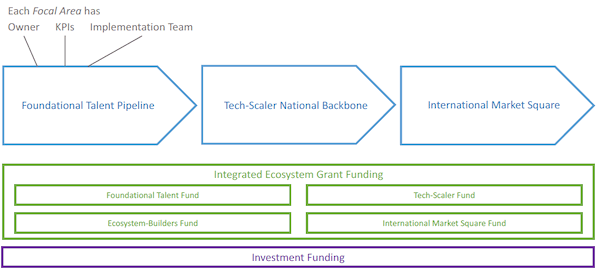Scottish technology ecosystem: review
Review of the Scottish tech ecosystem by Mark Logan, commissioned by the Scottish Government, with recommendations on how to develop a world-class tech sector.
Chapter 7 – Governance and Oversight Model
The recommendations in this review cover multiple, disparate areas, each with different stakeholders and owners. Some of the recommendations are naturally easier and faster to implement than others, some of which will take several years to fully implement. Only by a relentless and coordinated application of these recommendations will meaningful progress be made in improving outcomes from Scotland’s tech ecosystem.
However, we should recognise that such an approach is not necessarily the default model for multi-agency programmes in Scotland; it will not spontaneously form around these recommendations of its own accord. It’s naturally more convenient for our various agencies and institutions to manage to their own KPIs and imperatives. To overcome such potential inertia as regards this initiative, we propose the following principles for governing the programme. If all stakeholders operate to these principles, the initiative is likely to be transformative to ecosystem outcomes, otherwise results will be incremental and unremarkable.
Principles for Governance and Oversight
In the principles below, we use the term programme to refer to the delivery of the collective recommendations contained in this review.
- The programme should be designated as a primary strategic goal of the Scottish Government. Such a designation creates more impetus for stakeholders to work together to deliver it. A Scottish Government Cabinet Secretary should own the programme and be accountable for its outcomes.
- All participating agencies and institutions should explicitly and publicly commit to the delivery of the programme. Where an institution is unable or unwilling to make such a commitment, and where practical, the party should be removed from involvement in the programme and other routes to implementation sought. Passive resistance is an effective mechanism for suffocating a programme of this nature. We should be realistic about that.
- Where possible, all participating agencies and institutions should be strategically incentivised to deliver the programme outcomes. Without this incentivisation, the risk is that some participants pay nominal attention to the programme but subordinate it to local considerations. Participating parties need some reason to spend time and energy on a programme that doesn’t immediately deliver some local benefit in return for that effort.
- A Programme Management Office (PMO) should be set-up to manage delivery of the programme, run by a senior Programme Director, who reports to the Owning Cabinet Secretary. The programme is broad and complex. It will require intensive and continuous management. A multi-agency approach won’t work without over-arching coordination by a properly-supported, single responsible party.
- All stakeholders should use the ecosystem model described in this document as the basis for assessing interventions, measurement and outcomes. The importance of this point is that the programme will not be successful unless all stakeholders share a common terminology and appreciation of its goals, and a shared understanding of its operating mechanisms.
- Governance of the programme should include people who actually work within the ecosystem, and who understand it. Otherwise the programme will drift from its original purpose and imperatives.
- The programme should avoid “over-coordination” and “bureaucracy as the goal”. In formulating these proposals, we recognise that over-coordination is detrimental to the ecosystem’s goals; we would risk retarding the work of the many organisations and volunteers that support our technology industry already. An approach must be sought that provides the necessary level of coordination but no more than that; the agility and independence needed by ecosystem participants to evolve our ecosystem at world-class pace must be preserved.
- The PMO should operate a balanced scorecard, based on the five focal areas. The scorecard would provide a summary means of tracking progress over the lifetime of the initial programme, and beyond if necessary.

Governance Operating Model
The PMO would be responsible for implementing the above principles and reporting on progress against the balanced scorecard. It would be structured as follows (titles are nominal):
- Senior Programme Director, reporting to the Owning Cabinet Secretary.
- Foundational Talent Pipeline Programme Manager
Recapping, this focal area groups recommendations for interventions and improvements at School and University level as well as “funnel wideners” such as Codeclan, extra-curricular organisations, and the attraction of external talent and experience into the ecosystem. - Tech-Scaler National Backbone Programme Manager
This focal area concerns building a national network of “Tech-Scalers”, combining best practice in incubation and acceleration and including integrated grant funding. - International Market square Programme Manager This focal area groups recommendations designed to enhance Scotland’s market square activities, across all levels of scale from small meet-up to international conferences.
- Integrated Ecosystem Grant Funding Programme Manager This focal area groups all recommendations designed to align public grant funding support to the above areas. The emphasis in this category is on achieving close alignment to the ecosystem’s needs.
- Investment Funding Programme Manager This focal area groups all recommendations designed to better support the flow of investment funding to start-ups.
As necessary, the owning Programme Manager in a given focal area would convene a sub-group, consisting of representatives from the key stakeholders, including those that directly work within the industry, its agencies and institutions to coordinate the tracking and implementation of recommendations.
Of course, variations on this model exist. The point we wish to emphasise is that, in a programme with such a broad scope and which requires the active participation of multiple agencies over a long period of time, the risk of outcomes dissipating to zero is high without the up-front buy-in of all participants and the ongoing intensive application of the above principles.
Contact
Email: loganreview@gov.scot
There is a problem
Thanks for your feedback